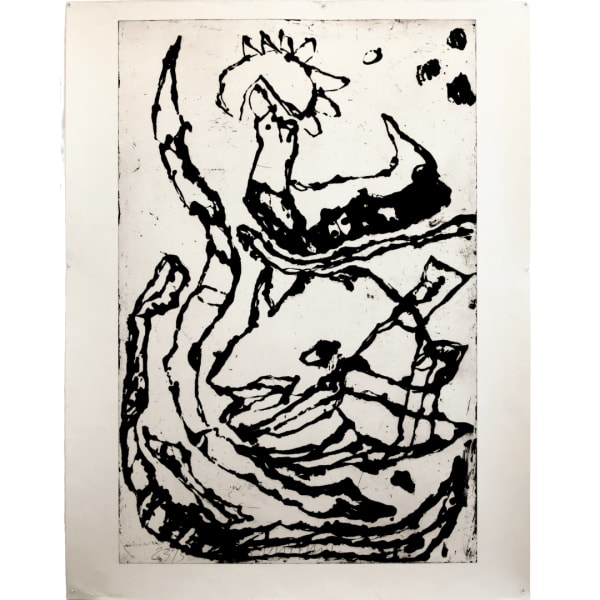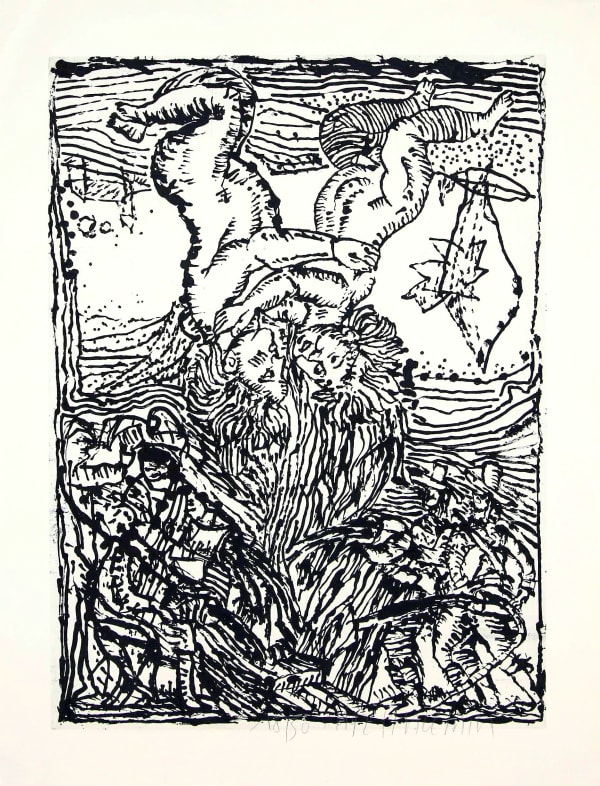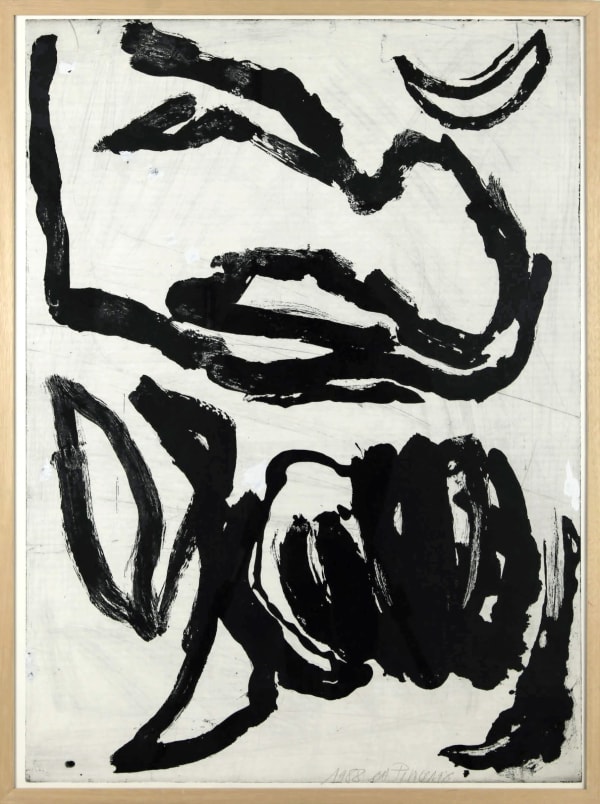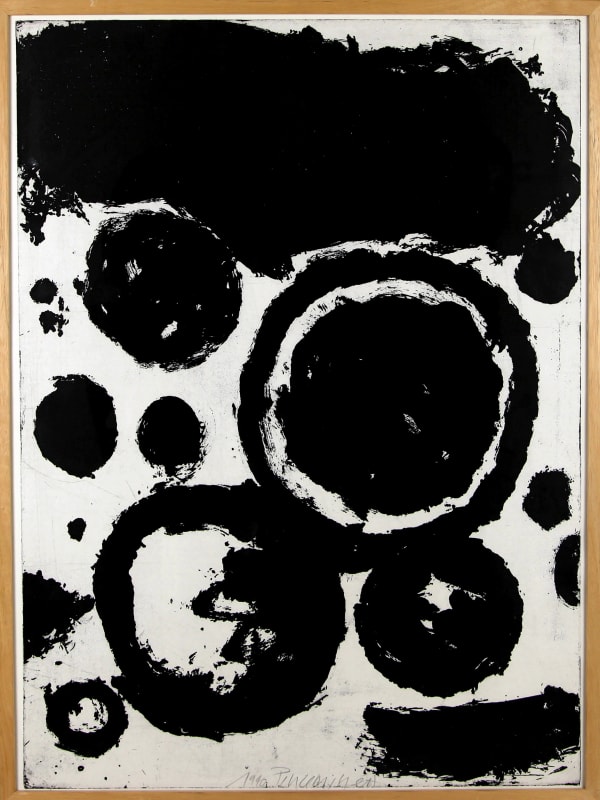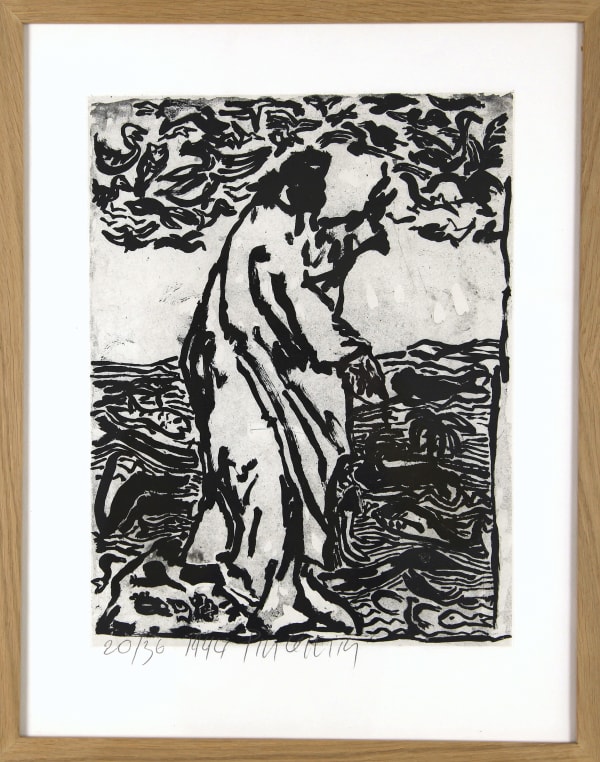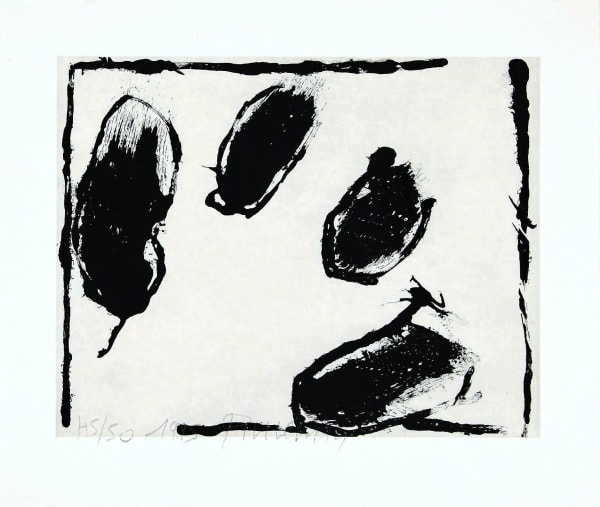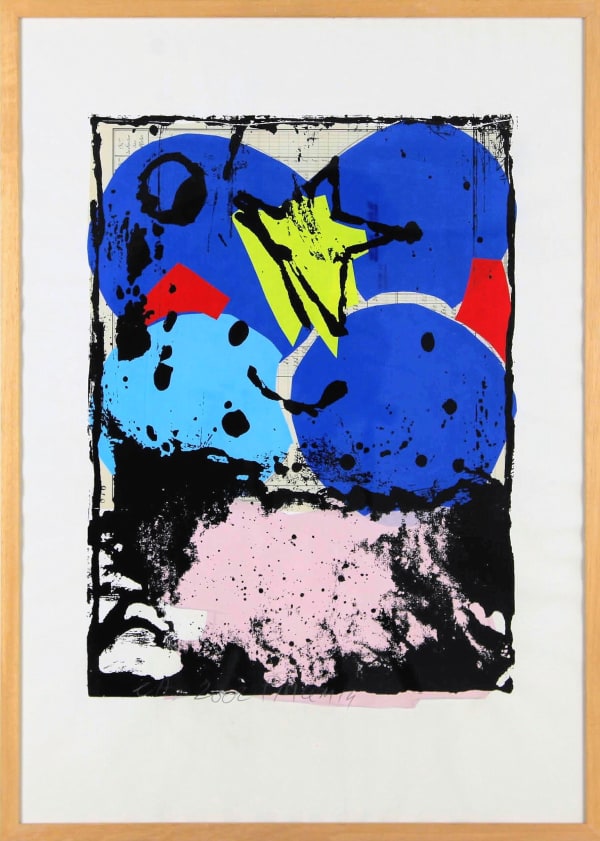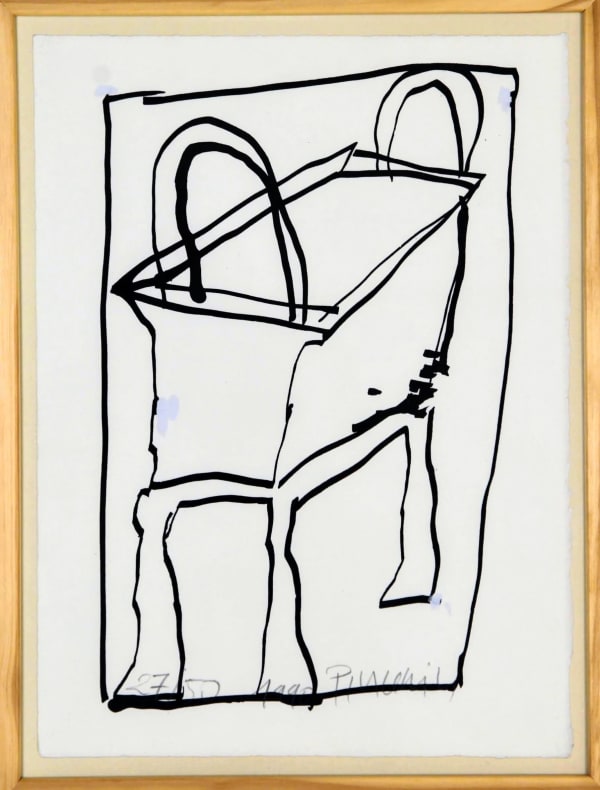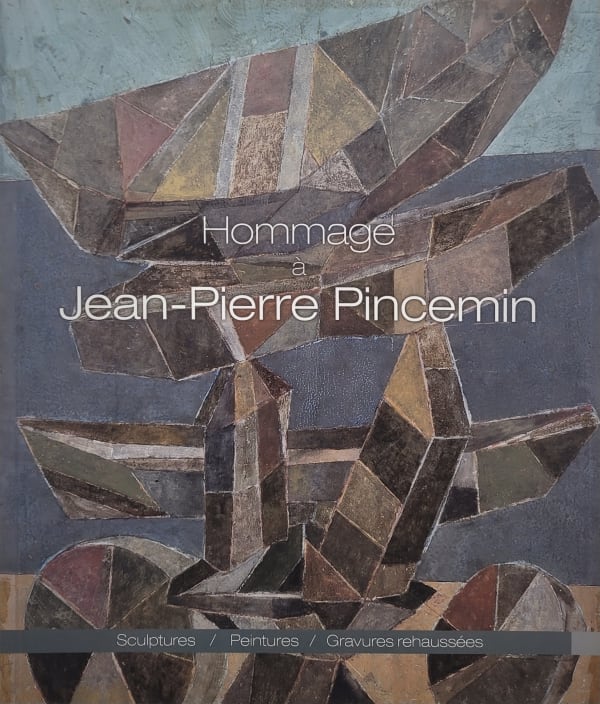Jean-Pierre Pincemin: Graveur
- Overview
- Virtual Exhibition
- Selection of works
- Installation Views
- Related content
-
Share
- X
- Tumblr
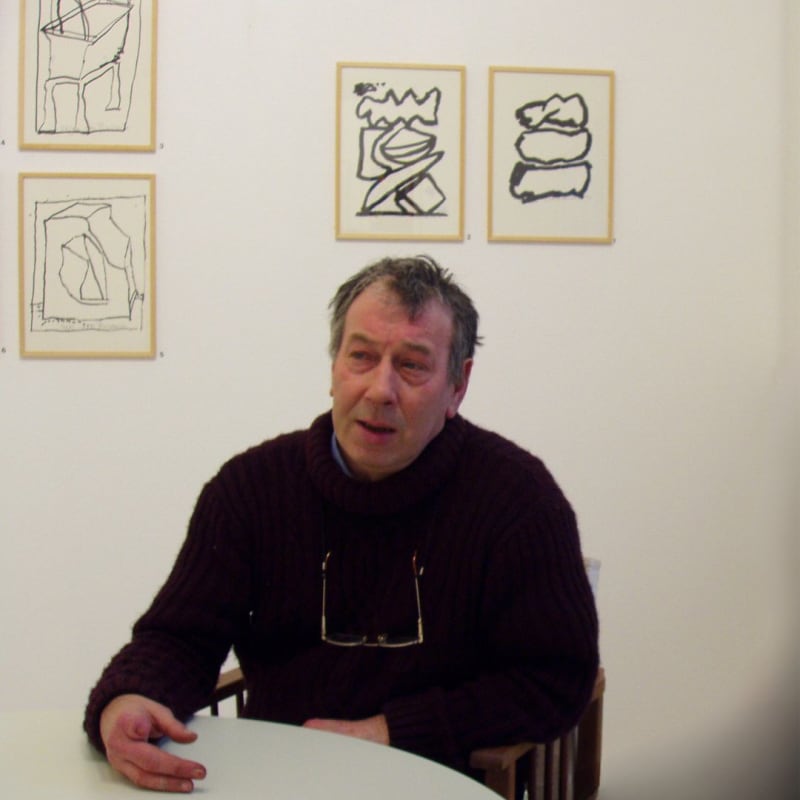
The works of Jean-Pierre Pincemin, who died in 2005, are rare and precious. Galerie Oniris pays tribute to him with this exhibition of large-format engravings and prints.
The selection of works presented in this exhibition crosses the different universes the artist worked on in his etchings, sometimes abstract or figurative, black & white or colored or even, sometimes enhanced. In his etchings, Jean-Pierre Pincemin did not seek to make copies of his paintings, but approached the etching process as an investigation in its own right, with unprecedented approaches.
""An etching is successful when it approaches a kind of very free, rapid writing, where only one idea is expressed at a time, as in a conversation. The painter rediscovers simple, direct or rather figurative forms, and the engraving, sincere and authentic, touches the most intimate part of the work"" - JP Pincemin, 1997
In this exhibition, the selection focuses on large and very large engravings. It covers 25 years of work, from the 70s with the "Canti" [abstract paintings created by the artist on selected pages of a book by Louis Dalla Fior in 1975] to the early 2000s.
SOLO EXHIBITION OF (LARGE) ENGRAVINGS BY JEAN-PIERRE PINCEMIN, AT THE GALLERY IN RENNES FROM APRIL 13 TO MAY 11 2024
The gallery is closed on French public holidays (May 1st, 8th and 9th) / opening hours as usual on other days: Tuesday to Saturday from 2pm to 7pm + mornings by appointment.
Born in Paris in 1944, Pincemin started out as a factory mechanic before discovering painting at the Louvre. His first exhibition dates back to 1968. He experimented with a whole series of gestures far removed from traditional brushwork: folds, imprints on corrugated iron, impressions of bricks and wire mesh, acting on the canvas like a new material. From 1968 to 1973, he began working with "carrés collés", in which the canvas is dipped in dye baths, cut out and assembled into irregular square or rectangular geometric figures. As early as 1971, he joined the "Support-Surface" movement, created in the late 1960s, which asserted the physical reality of the painting, begun by Matisse with his paper cut-outs, continued by New Abstraction and Hard Edge in the USA, and in France by Simon Hantaï or Claude Viallat. At the end of the 90s, the artist decided to "sweep up and assimilate everything", executing polychrome sculptures using pieces of painted wood, which we have been able to discover in the course of his exhibitions.
click on the image above to access the virtual tour without any installation on your device
-
 Jean-Pierre PINCEMIN1944 - 2005Sans titre (Canti), 1975Ensemble de 5 peintures uniques acrylique sur papier chiffon accompagnant le livre d'artiste "Canti II et IIX" peintures JP Pincemin + textes Louis Dalla Fior / tirage limité à 30 exemplaires
Jean-Pierre PINCEMIN1944 - 2005Sans titre (Canti), 1975Ensemble de 5 peintures uniques acrylique sur papier chiffon accompagnant le livre d'artiste "Canti II et IIX" peintures JP Pincemin + textes Louis Dalla Fior / tirage limité à 30 exemplaires
Set of 5 unique acrylic paintings on rag paper accompanying the artist's book “Canti II et IIX” paintings JP Pincemin + texts Louis Dalla Fior33 x 26 cm X 5Exemplaire n°16/30 (avec le livre)€ 19,000.00 -
 Jean-Pierre PINCEMIN1944 - 2005Empreintes (réf. 191), 1992Lithographie sur papier rehaussé à la main
Jean-Pierre PINCEMIN1944 - 2005Empreintes (réf. 191), 1992Lithographie sur papier rehaussé à la main
Lithography on hand-embellished paper160 x 120 cm
63 x 47 1/4 inn°01/30 -
 Jean-Pierre PINCEMIN1944 - 2005Sans titre (Children's corner), 1997Peinture sur papier (gravure) réhaussé et marouflé sur bois
Jean-Pierre PINCEMIN1944 - 2005Sans titre (Children's corner), 1997Peinture sur papier (gravure) réhaussé et marouflé sur bois
Painting on paper (engraving) enhanced and mounted on wood60 x 41 cmGalerie Oniris - Jean-Pierre PINCEMIN, Sans titre (Children's corner), 1997Sold€ 11,000.00 -
 Jean-Pierre PINCEMIN1944 - 2005Sans titre (réf : 151), 1991Aquatinte au sucre sur papier rehaussée de peinture blanche
Jean-Pierre PINCEMIN1944 - 2005Sans titre (réf : 151), 1991Aquatinte au sucre sur papier rehaussée de peinture blanche
Aquatint with sugar on paper enhanced with white paint123.8 x 84.4 cm
48 3/4 x 33 1/4 inn° 04/50Galerie Oniris - Jean-Pierre PINCEMIN, Sans titre (réf : 151), 1991Sold€ 4,000.00 -
 Jean-Pierre PINCEMIN1944 - 2005Sans titre (réf : 146), 1990Aquatinte au sucre sur papier rehaussée de peinture blanche
Jean-Pierre PINCEMIN1944 - 2005Sans titre (réf : 146), 1990Aquatinte au sucre sur papier rehaussée de peinture blanche
Aquatint with sugar on paper enhanced with white paint123.7 x 84.5 cm
48 3/4 x 30 1/2 inn° 50/50Galerie Oniris - Jean-Pierre PINCEMIN, Sans titre (réf : 146), 1990Sold€ 4,000.00 -
 Jean-Pierre PINCEMIN1944 - 2005Sans titre (réf : 150), 1991Aquatinte au sucre sur papier rehaussée de peinture blanche
Jean-Pierre PINCEMIN1944 - 2005Sans titre (réf : 150), 1991Aquatinte au sucre sur papier rehaussée de peinture blanche
Aquatint with sugar on paper enhanced with white paint124.2 x 83.5 cm
49 x 32 3/4 inn° 02/50Galerie Oniris - Jean-Pierre PINCEMIN, Sans titre (réf : 150), 1991Sold€ 4,000.00 -
 Jean-Pierre PINCEMIN1944 - 2005Sans titre (réf : 148), 1990Aquatinte au sucre sur papier rehaussée de peinture blanche
Jean-Pierre PINCEMIN1944 - 2005Sans titre (réf : 148), 1990Aquatinte au sucre sur papier rehaussée de peinture blanche
Aquatint with sugar on paper enhanced with white paint129.2 x 98.8 cm
50 3/4 x 39 inn° 23/50Galerie Oniris - Jean-Pierre PINCEMIN, Sans titre (réf : 148), 1990Sold€ 4,000.00 -
 Jean-Pierre PINCEMIN1944 - 2005Sans titre (réf : 152), 1991Aquatinte au sucre sur papier rehaussée de peinture blanche
Jean-Pierre PINCEMIN1944 - 2005Sans titre (réf : 152), 1991Aquatinte au sucre sur papier rehaussée de peinture blanche
Aquatint with sugar on paper enhanced with white paint124 x 83.5 cm
48 3/4 x 32 3/4 inn° 50/50Galerie Oniris - Jean-Pierre PINCEMIN, Sans titre (réf : 152), 1991Sold€ 4,000.00 -
 Jean-Pierre PINCEMIN1944 - 2005Sans titre (réf : 184), 1992Aquatinte au sucre sur papier
Jean-Pierre PINCEMIN1944 - 2005Sans titre (réf : 184), 1992Aquatinte au sucre sur papier
Aquatint with sugar on paper87.5 x 67.3 cm
34 1/2 x 26 1/2 inn° 18/50Galerie Oniris - Jean-Pierre PINCEMIN, Sans titre (réf : 184), 1992Sold€ 1,600.00 -
 Jean-Pierre PINCEMIN1944 - 2005Sans titre (réf : 133), 1990Aquatinte au sucre sur papier
Jean-Pierre PINCEMIN1944 - 2005Sans titre (réf : 133), 1990Aquatinte au sucre sur papier
Aquatint with sugar on paper48.5 x 36.5 cm
19 1/4 x 14 1/4 inn° 27/50Galerie Oniris - Jean-Pierre PINCEMIN, Sans titre (réf : 133), 1990Sold€ 1,500.00 -
 Jean-Pierre PINCEMIN1944 - 2005Sans titre (réf : 185), 1992Aquatinte au sucre sur papier
Jean-Pierre PINCEMIN1944 - 2005Sans titre (réf : 185), 1992Aquatinte au sucre sur papier
Aquatint with sugar on paper77.6 x 62.8 cm
30 1/2 x 24 3/4 inn° 14/50Galerie Oniris - Jean-Pierre PINCEMIN, Sans titre (réf : 185), 1992Sold€ 1,500.00 -
 Jean-Pierre PINCEMIN1944 - 2005Sans titre (réf : 136), 1990Aquatinte au sucre sur papier rehaussée de peinture blanche
Jean-Pierre PINCEMIN1944 - 2005Sans titre (réf : 136), 1990Aquatinte au sucre sur papier rehaussée de peinture blanche
Aquatint with sugar on paper enhanced with white paint48.5 x 37.7 cm
19 1/4 x 14 3/4 inExemplaire d'Artiste - EAGalerie Oniris - Jean-Pierre PINCEMIN, Sans titre (réf : 136), 1990Sold€ 1,500.00 -
 Jean-Pierre PINCEMIN1944 - 2005Sans titre (réf : 139), 1990Aquatinte au sucre sur papier
Jean-Pierre PINCEMIN1944 - 2005Sans titre (réf : 139), 1990Aquatinte au sucre sur papier
Aquatint with sugar on paper76 x 56.5 cm
30 x 22 1/4 inExemplaire d'Artiste - EAGalerie Oniris - Jean-Pierre PINCEMIN, Sans titre (réf : 139), 1990Sold€ 1,500.00 -
 Jean-Pierre PINCEMIN1944 - 2005Sans titre (réf : 143), 1990Aquatinte au sucre sur papier
Jean-Pierre PINCEMIN1944 - 2005Sans titre (réf : 143), 1990Aquatinte au sucre sur papier
Aquatint with sugar on paper76 x 56.5 cm
30 x 22 1/4 inExemplaire d'Artiste - EAGalerie Oniris - Jean-Pierre PINCEMIN, Sans titre (réf : 143), 1990Sold€ 1,500.00 -
 Jean-Pierre PINCEMIN1944 - 2005Sonnet XIV de William Shakespare, 1990Aquatinte au sucre sur papier
Jean-Pierre PINCEMIN1944 - 2005Sonnet XIV de William Shakespare, 1990Aquatinte au sucre sur papier
Aquatint with sugar on paper76 x 56.5 cm
30 x 22 1/4 inExemplaire d'Artiste - EAGalerie Oniris - Jean-Pierre PINCEMIN, Sonnet XIV de William Shakespare, 1990Sold€ 1,500.00 -
 Jean-Pierre PINCEMIN1944 - 2005Sans titre (réf : 142), 1990Aquatinte au sucre sur papier
Jean-Pierre PINCEMIN1944 - 2005Sans titre (réf : 142), 1990Aquatinte au sucre sur papier
Aquatint with sugar on paper76 x 56.5 cm
30 x 22 1/4 inExemplaire d'Artiste - EAGalerie Oniris - Jean-Pierre PINCEMIN, Sans titre (réf : 142), 1990Sold€ 1,500.00 -
 Jean-Pierre PINCEMIN1944 - 2005Sans titre (réf : 138), 1990Aquatinte au sucre sur papier
Jean-Pierre PINCEMIN1944 - 2005Sans titre (réf : 138), 1990Aquatinte au sucre sur papier
Aquatint with sugar on paper76 x 56.5 cm
30 x 22 1/4 inn° 15/50Galerie Oniris - Jean-Pierre PINCEMIN, Sans titre (réf : 138), 1990Sold -
 Jean-Pierre PINCEMIN1944 - 2005Sans titre, 1999Lithogravure sur papier
Jean-Pierre PINCEMIN1944 - 2005Sans titre, 1999Lithogravure sur papier
Lithograph on paper75 x 56 cm
29 1/2 x 22 1/4 inn° 11/20Galerie Oniris - Jean-Pierre PINCEMIN, Sans titre, 1999Sold€ 950.00 -
 Jean-Pierre PINCEMIN1944 - 2005Sans titre (réf : 197), 1993Aquatinte au sucre sur papier
Jean-Pierre PINCEMIN1944 - 2005Sans titre (réf : 197), 1993Aquatinte au sucre sur papier
Aquatint with sugar on paper36.6 x 33.2 cm
14 1/2 x 13 1/4 inn° 20/36Galerie Oniris - Jean-Pierre PINCEMIN, Sans titre (réf : 197), 1993Sold€ 750.00 -
 Jean-Pierre PINCEMIN1944 - 2005Sans titre (réf : 179), 1991Aquatinte au sucre sur papier
Jean-Pierre PINCEMIN1944 - 2005Sans titre (réf : 179), 1991Aquatinte au sucre sur papier
Aquatint with sugar on paper46.5 x 35.5 cm
18 1/4 x 14 inn° 17/50Galerie Oniris - Jean-Pierre PINCEMIN, Sans titre (réf : 179), 1991Sold€ 750.00 -
 Jean-Pierre PINCEMIN1944 - 2005Sans titre (réf : 174), 1991Aquatinte au sucre sur papier
Jean-Pierre PINCEMIN1944 - 2005Sans titre (réf : 174), 1991Aquatinte au sucre sur papier
Aquatint with sugar on paper45.7 x 31.8 cm
18 x 12 1/2 inn° 18/50Galerie Oniris - Jean-Pierre PINCEMIN, Sans titre (réf : 174), 1991Sold€ 750.00 -
 Jean-Pierre PINCEMIN1944 - 2005Sans titre, 1999Lithographie sur papier
Jean-Pierre PINCEMIN1944 - 2005Sans titre, 1999Lithographie sur papier
Lithograph on paper65 x 50 cm
25 1/2 x 19 3/4 inn° 11/20Galerie Oniris - Jean-Pierre PINCEMIN, Sans titre, 1999Sold€ 750.00 -
 Jean-Pierre PINCEMIN1944 - 2005Sans titre (réf : 244), 1995Aquatinte au sucre sur papier
Jean-Pierre PINCEMIN1944 - 2005Sans titre (réf : 244), 1995Aquatinte au sucre sur papier
Aquatint with sugar on paper40.3 x 47 cm
15 3/4 x 18 1/2 inn° 45/50Galerie Oniris - Jean-Pierre PINCEMIN, Sans titre (réf : 244), 1995Sold -
 Jean-Pierre PINCEMIN1944 - 2005Micromégas #3, 2002Sérigraphie et collage sur papier
Jean-Pierre PINCEMIN1944 - 2005Micromégas #3, 2002Sérigraphie et collage sur papier
Silkscreen and collage on paper65 x 46 cm
25 1/2 x 18 1/4 inn° 07/19Galerie Oniris - Jean-Pierre PINCEMIN, Micromégas #3, 2002Sold€ 700.00 -
 Jean-Pierre PINCEMIN1944 - 2005Micromégas #4, 2002Sérigraphie et collage sur papier
Jean-Pierre PINCEMIN1944 - 2005Micromégas #4, 2002Sérigraphie et collage sur papier
Silkscreen and collage on paper65 x 46 cm
25 1/2 x 18 1/4 inn° 04/19Galerie Oniris - Jean-Pierre PINCEMIN, Micromégas #4, 2002Sold€ 700.00 -
 Jean-Pierre PINCEMIN1944 - 2005Sans titre (réf : 243), 1995Aquatinte au sucre sur papier
Jean-Pierre PINCEMIN1944 - 2005Sans titre (réf : 243), 1995Aquatinte au sucre sur papier
Aquatint with sugar on paper30 x 37.7 cm
11 3/4 x 14 3/4 inn° 31/50Galerie Oniris - Jean-Pierre PINCEMIN, Sans titre (réf : 243), 1995Sold -
 Jean-Pierre PINCEMIN1944 - 2005Sans titre (réf : 220), 1994Aquatinte au sucre sur papier
Jean-Pierre PINCEMIN1944 - 2005Sans titre (réf : 220), 1994Aquatinte au sucre sur papier
Aquatint with sugar on paper33.5 x 22.6 cm
13 1/4 x 9 inn° 25/36Galerie Oniris - Jean-Pierre PINCEMIN, Sans titre (réf : 220), 1994Sold€ 500.00 -
 Jean-Pierre PINCEMIN1944 - 2005Sans titre (ref : 126), 1990Lithographie sur papier rehaussée de peinture blanche
Jean-Pierre PINCEMIN1944 - 2005Sans titre (ref : 126), 1990Lithographie sur papier rehaussée de peinture blanche
Lithograph on paper enhanced with white paint37.3 x 27.6 cm
14 3/4 x 10 3/4 inn° 27/50Galerie Oniris - Jean-Pierre PINCEMIN, Sans titre (ref : 126), 1990Sold€ 450.00 -
 Jean-Pierre PINCEMIN1944 - 2005Sans titre (réf : 129), 1990Lithographie sur papier rehaussée de peinture blanche
Jean-Pierre PINCEMIN1944 - 2005Sans titre (réf : 129), 1990Lithographie sur papier rehaussée de peinture blanche
Lithograph on paper enhanced with white paint29.5 x 24.2 cm
11 1/2 x 9 1/2 inn° 28/50Galerie Oniris - Jean-Pierre PINCEMIN, Sans titre (réf : 129), 1990Sold€ 450.00 -
 Jean-Pierre PINCEMINSans titre (réf. 177), 1991Sérigraphie sur papier signée et datée par l'artiste
Jean-Pierre PINCEMINSans titre (réf. 177), 1991Sérigraphie sur papier signée et datée par l'artiste
Silkscreen on paper signed and dated by the artist
33.5 x 23 cm
13 1/4 x 9 1/4 in
Exemplaire signé non -numérotéGalerie Oniris - Jean-Pierre PINCEMIN, Sans titre (réf. 177), 1991Sold€ 250.00






